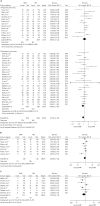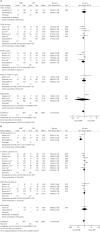Comparison of Robot-Assisted Radical Prostatectomy and Open Radical Prostatectomy Outcomes: A Systematic Review and Meta-Analysis
- PMID: 27401648
- PMCID: PMC4960383
- DOI: 10.3349/ymj.2016.57.5.1165
Comparison of Robot-Assisted Radical Prostatectomy and Open Radical Prostatectomy Outcomes: A Systematic Review and Meta-Analysis
Abstract
Purpose: To systematically update evidence on the clinical efficacy and safety of robot-assisted radical prostatectomy (RARP) versus retropubic radical prostatectomy (RRP) in patients with prostate cancer.
Materials and methods: Electronic databases, including ovidMEDLINE, ovidEMBASE, the Cochrane Library, KoreaMed, KMbase, and others, were searched, collecting data from January 1980 to August 2013. The quality of selected systematic reviews was assessed using the revised assessment of multiple systematic reviews and the modified Cochrane Risk of Bias tool for non-randomized studies.
Results: A total of 61 studies were included, including 38 from two previous systematic reviews rated as best available evidence and 23 additional studies that were more recent. There were no randomized controlled trials. Regarding safety, the risk of complications was lower for RARP than for RRP. Among functional outcomes, the risk of urinary incontinence was lower and potency rate was significantly higher for RARP than for RRP. Regarding oncologic outcomes, positive margin rates were comparable between groups, and although biochemical recurrence (BCR) rates were lower for RARP than for RRP, recurrence-free survival was similar after long-term follow up.
Conclusion: RARP might be favorable to RRP in regards to post-operative complications, peri-operative outcomes, and functional outcomes. Positive margin and BCR rates were comparable between the two procedures. As most of studies were of low quality, the results presented should be interpreted with caution, and further high quality studies controlling for selection, confounding, and selective reporting biases with longer-term follow-up are needed to determine the clinical efficacy and safety of RARP.
Keywords: Prostatic neoplasms; meta-analysis; prostatectomy; robotics.
Conflict of interest statement
The authors have no financial conflicts of interest.
Figures





Similar articles
-
Systematic review and meta-analysis of studies reporting urinary continence recovery after robot-assisted radical prostatectomy.Eur Urol. 2012 Sep;62(3):405-17. doi: 10.1016/j.eururo.2012.05.045. Epub 2012 Jun 1. Eur Urol. 2012. PMID: 22749852
-
Laparoscopic and robotic-assisted versus open radical prostatectomy for the treatment of localised prostate cancer.Cochrane Database Syst Rev. 2017 Sep 12;9(9):CD009625. doi: 10.1002/14651858.CD009625.pub2. Cochrane Database Syst Rev. 2017. PMID: 28895658 Free PMC article.
-
Robot-assisted radical prostatectomy has lower biochemical recurrence than laparoscopic radical prostatectomy: Systematic review and meta-analysis.Investig Clin Urol. 2017 May;58(3):152-163. doi: 10.4111/icu.2017.58.3.152. Epub 2017 Apr 28. Investig Clin Urol. 2017. PMID: 28480340 Free PMC article.
-
Best practices in robot-assisted radical prostatectomy: recommendations of the Pasadena Consensus Panel.Eur Urol. 2012 Sep;62(3):368-81. doi: 10.1016/j.eururo.2012.05.057. Epub 2012 Jun 7. Eur Urol. 2012. PMID: 22763081
-
Retzius Sparing Radical Prostatectomy Versus Robot-assisted Radical Prostatectomy: Which Technique Is More Beneficial for Prostate Cancer Patients (MASTER Study)? A Systematic Review and Meta-analysis.Eur Urol Focus. 2022 Jul;8(4):1060-1071. doi: 10.1016/j.euf.2021.08.003. Epub 2021 Aug 21. Eur Urol Focus. 2022. PMID: 34429272
Cited by
-
National practice patterns and direct medical costs for prostate cancer in Korea across a 10 year period: a nationwide population-based study using a national health insurance database.BMC Health Serv Res. 2019 Jun 24;19(1):408. doi: 10.1186/s12913-019-4218-7. BMC Health Serv Res. 2019. PMID: 31234845 Free PMC article.
-
Blood transfusion had no influence on the 5-year biochemical recurrence after robot-assisted radical prostatectomy: a retrospective study.BMC Urol. 2021 Nov 17;21(1):160. doi: 10.1186/s12894-021-00926-0. BMC Urol. 2021. PMID: 34789219 Free PMC article.
-
Robotics in urology.Ann R Coll Surg Engl. 2018 May;100(6_sup):38-44. doi: 10.1308/rcsann.supp1.38. Ann R Coll Surg Engl. 2018. PMID: 29717888 Free PMC article.
-
Outcomes and efficacy of robotic-assisted radical prostatectomy using the CMR Versius platform: a prospective study on 118 patients with 1-year follow-up.Int Urol Nephrol. 2025 Jul;57(7):2081-2087. doi: 10.1007/s11255-025-04384-7. Epub 2025 Jan 30. Int Urol Nephrol. 2025. PMID: 39883272
-
Effects of Perioperative Epidural Analgesia on Cancer Recurrence and Survival.Front Oncol. 2022 Jan 5;11:798435. doi: 10.3389/fonc.2021.798435. eCollection 2021. Front Oncol. 2022. PMID: 35071003 Free PMC article. Review.
References
-
- Yates DR, Vaessen C, Roupret M. From Leonardo to da Vinci: the history of robot-assisted surgery in urology. BJU Int. 2011;108:1708–1713. - PubMed
-
- Heidenreich A, Bellmunt J, Bolla M, Joniau S, Mason M, Matveev V, et al. EAU guidelines on prostate cancer. Part 1: screening, diagnosis, and treatment of clinically localised disease. Eur Urol. 2011;59:61–71. - PubMed
-
- Hakimi AA, Feder M, Ghavamian R. Minimally invasive approaches to prostate cancer: a review of the current literature. Urol J. 2007;4:130–137. - PubMed
-
- Kang DC, Hardee MJ, Fesperman SF, Stoffs TL, Dahm P. Low quality of evidence for robot-assisted laparoscopic prostatectomy: results of a systematic review of the published literature. Eur Urol. 2010;57:930–937. - PubMed
Publication types
MeSH terms
LinkOut - more resources
Full Text Sources
Other Literature Sources
Medical
Research Materials

